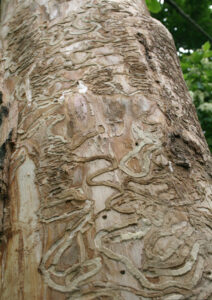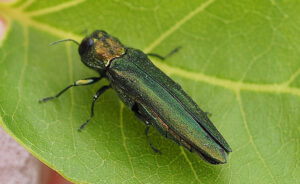
The dangers of monoculture
By Denis Crawford
The arrival of an exotic herbivorous insect in an environment dominated by only a few plant species can be a recipe for disaster.
When an insect is introduced into an area with few natural pathogens, parasites and predators, that insect may become a severe pest. Insect pests introduced to Australia include many aphid species, cabbage white butterfly (Pieris rapae), elm leaf beetle (Xanthogaleruca luteola), European wasp (Vespula germanica), and red imported fire ant (Solenopsis invicta), among many others. Common predators such as lacewings or ladybirds will often tackle a new insect but, if they are not in sufficient numbers and there are no pest specific parasites or pathogens in support, they may lose the battle.
One solution to this problem in commercial agriculture and horticulture has been to introduce parasitic insects specific to a particular pest. Sometimes, the introduced parasites will be successful, such as the introduction of the greenhouse whitefly parasite (Encarsia formosa) which is now the premier biological control agent for greenhouse whitefly (Trialeurodes vaporariorum) in Australia. Biological control agents for other pest insects such as elm leaf beetle and red imported fire ant have proved elusive so far.

(Supplied by Denis Crawford of Graphic Science)
Monoculture makes things even worse. A concentration of many thousands of food plants of the same type (i.e., a crop) is irresistible to plant-eating insects. Monoculture modifies the environment to such an extent that it not only favours some insect species (pests) but inhibits others (some of which are beneficial insects). For example, the native plant species which were in an area before a crop was planted may have harboured predators or parasites of a number of pest species. Removing those native plants can cause beneficial insect populations to collapse, which in turn may cause pest insect numbers in the crop to explode.
If I am speaking to a gardening group on this subject, around about now I say something like “In our gardens we can avoid this by growing a diverse range of plants”. We have known this works for a long time, but some of the mechanisms involved haven’t been fully understood. A scientific paper (Wetzel, W. et al, 2016) I read recently, fills in some of the gaps. The key findings were:
- Monoculture crops provide the nutrient levels insect pests crave.
- Fields with a variety of plants provide inconsistent nutrient levels for insect pests, so the pests do poorly.
- Returning plant diversity to farms could be a key step toward sustainable pest control.
- Mixing genotypes of the same crop species could add diversity without hurting production levels.
You may have noticed the last point in the above list about mixing genotypes. This has been tried before, successfully, with disease control but not, as far as I can tell, for insect pest control. I found an example in rice, where disease-susceptible rice varieties were planted in mixtures with resistant varieties. The experiment was so successful that fungicidal sprays were no longer applied by the end of the two-year programme.
I found a great quote about monoculture from the author of the paper mentioned. “A monoculture is like a buffet for plant-eating insects where every dish is delicious,” Wetzel said. “A variable crop is like a buffet where every other dish is nasty.”
A classic example of what can happen when an exotic insect meets monoculture is playing out in North America right now. A jewel beetle native to north-eastern Asia, the emerald ash borer (Agrilus planipennis), was accidentally introduced into North America. It was identified in Michigan and Ontario in 2002, but the theory is that it arrived in packing crates as early as the 1990s. The invasive pest is devastating the ash trees (Fraxinus spp.) of North America.
The adult beetles feed on small amounts of ash foliage, but the main damage is caused by the wood-boring larvae which feed in the cambium, and also tunnel into the sapwood. Larval tunnels effectively girdle the phloem and scar the outer sapwood, restricting nutrient and water transport within the tree. Severely infested trees die.

(Supplied by Denis Crawford of Graphic Science)
Emerald ash borer has killed millions of trees so far in North America, and the high-impact zone of the pest covers nearly one million square kilometres. Emerald ash beetle is not just a problem in ash forests. As many of you know, ash trees are the main urban street trees in many states of the US and some provinces in Canada. The emerald ash borer is expected to kill virtually all ash trees within the United States (Hudgins etal, 2022). Parasitoids of the emerald ash borer have been introduced, but the long-term effect on emerald ash borer populations has yet to be determined.
The important thing to note here is that the emerald ash borer is not decimating the Fraxinus species in its native range in north-eastern Asia. The ash species there, such as Fraxinus chinensis, F. lanuginosa and F. mandshurica are more resistant, and emerald ash borer was given scientific scant attention until it arrived in North America. The ash species particularly under threat in North America are green ash (Fraxinus pennsylvanica), white ash (F. americana) and black ash (F. nigra).
When ash trees are growing right next to each other, such as trees lining urban streets, that encourages the emerald ash beetle to spread. When every street in every town in a region is lined with the same species of ash tree, the results are devastating.
Main photo: Damage caused by emerald ash borer larvae (Image: Troy Kimoto, Canadian Food Inspection Agency)
References:
Hudgins, E.J. et al, (2022) Hotspots of pest-induced US urban tree death, 2020–2050. Journal of Applied Ecology.
Wetzel, W. et al, (2016) Variability in plant nutrients reduces insect herbivore performance. Nature.
